
The cuneiform lu sign is a common, multi-use sign, a syllabic for lu, and an alphabetic sign used for l, or u; it has many other sub-uses, as seen in the Epic of Gilgamesh over hundreds of years, and the 1350 BC Amarna letters. Its other uses show other syllabic and alphabetic forms that it can be used for: other vowels, or consonants;. There are also four sumerogrammic sub-forms for "lu" in the Epic of Gilgamesh, LU, and UDU, and DAB and DIB; LU transposes to Akkadian language, "lullû", for English language, (primitive) man; DAB transposes to ṣabātu, English for to seize, capture.

The cuneiform ma sign, is found in both the 14th century BC Amarna letters and the Epic of Gilgamesh. In the Epic it is also used as the Sumerogram MA, . The ma sign is often used at the end of words, besides its alphabetic usage inside words as syllabic ma, elsewhere for m, or a.

The cuneiform Ne sign, is found in both the 14th century BC Amarna letters and the Epic of Gilgamesh. In the Amarna letters, it is especially used in the opening, and introductory paragraph of the clay tablet letter, when addressing the Pharaoh (King), or when sent to another individual who is part of the Pharaoh's correspondence, for the alternate syllabic usage of "bil",. In the Amarna letters, it is used as Bil (cuneiform), for the spelling of speaks, or "says", in the opening statement; the Akkadian language word is "qabû", for to say, tell.

The cuneiform sign 𒀀 for a, and in the Epic of Gilgamesh the sumerogram A, Akkadian for mû, "water", which is used in the Gilgamesh flood myth, Chapter XI of the Epic, or other passages. The sign is also used extensively in the Amarna letters.

The cuneiform Ri sign, or Re, is found in both the 14th-century BC Amarna letters and the Epic of Gilgamesh; it is in the top 25 most used cuneiform signs for ri, or re, but has other syllabic or alphabetic uses, as well as the Sumerogram usage for RI.

The cuneiform pa sign,, has many uses in both the 14th century BC Amarna letters and the Epic of Gilgamesh. It is routinely and commonly used to spell the Akkadian language word "pānu", face, presence, and with a preposition, before. In the photo of the obverse of EA 364, it is used to spell Akkadian "eperu", 'dust', (EA 364, lines 7,8: "...andand \ dust"-.
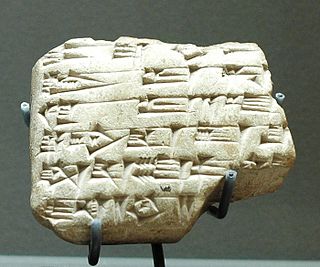
The cuneiform ia sign 𒅀, is a combined sign, containing i (cuneiform) ligatured with a (cuneiform); it has the common meaning in the suffix form -ia, for the meaning of "-mine". In the Amarna letters, the letters written to the Pharaoh of Egypt, the Pharaoh is often referenced as "Lord-mine", or especially: King-Lord-mine: "My King, My Lord". In Akkadian, the form is "Šarru-Bēlu-ia"-(King-Lord-mine), since the spelling in some Amarna letters is sometimes ŠÁR-RI for Šarru,.

The cuneiform DAGAL sign, which is a capital letter (majuscule) Sumerogram with the Akkadian language meaning of to be wide, or extensive; also "many", Akkadian "rapāšu", is a minor usage cuneiform sign used in the Amarna letters and the Epic of Gilgamesh. An equivalent usage sign for DAGAL is used in the Amarna letters, gáb, for Akkadian language "gabbu", and is found in such letters as EA 362, EA 367, and others. Gáb has other syllabic values, which are used for separate Akkadian word components.

The cuneiform sign for the syllable ab also represents that for ap, or the vowel and consonant usages of a, b, or p: in the Akkadian language "b" is unaspirated, formed with the lips, and "p" is aspirated, with the breath). In the Akkadian language "b" and "p" are interchangeable; also, in cuneiform texts, any vowel can be interchanged with any other. The ab/ap sign also has a corresponding capital letter (majuscule) usage as a sumerogram, as found in the Epic of Gilgamesh for AB, the Akkadian language for šību, meaning "elder".

The cuneiform i sign is a common use vowel sign. It can be found in many languages, examples being the Akkadian language of the Epic of Gilgamesh and the mid 14th-century BC Amarna letters; also the Hittite language-(see table of Hittite cuneiform signs below).

The cuneiform sign LÚ is the sign used for "man"; its complement is the symbol for woman: šal. Cuneiform LÚ, is found as a Sumerogram in the Epic of Gilgamesh. It also has a common usage in the 1350 BC Amarna letters as the Sumerogram for "man".
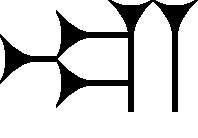
The cuneiform sign URU is a relatively distinctive sign in the cuneiform sign lists; with its two verticals at the sign's right, and the central long horizontal stroke, it is not easily confused with other signs. It is commonly found in the intrigues of the 14th century BC Amarna letters since the letters often concern city-state locations, or surrounding regions or cities/towns. URU is also used in the Epic of Gilgamesh. The cuneiform sign is almost exclusively used as a Sumerogram, and in the Akkadian language, it is the Akkadian for "ālu", city, or town. The usage of URU in the Epic of Gilgamesh is only for Sumerogram "URU",. All uses in the Epic for URU are for various spellings of ālu, and usually an added sign complement; there is one usage in the Epic of URU for the city Shuruppak: URU.Šu-ri-ip-pak,.

The cuneiform mi, sign is a distinctive sign in the wedge-stroke group, and is used as a syllabic for mi, me, and an alphabetic for m, i, or e; it is also a Sumerogram for MI, used for Akkadian language, "mūšu", night. MI, in the Epic of Gilgamesh, is used in (Chapters) Tablets I, II, III, and XII as either MI, or MI.MEŠ, a total of six times; other spellings of mūšu in other sections are alphabetic/syllabic, four times.
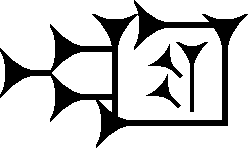
The cuneiform ud sign, also ut, and with numerous other syllabic and Sumerogram uses, is a common sign for the mid 14th-century BC Amarna letters and the Epic of Gilgamesh. The sign is constructed upon the single vertical stroke , with various positionings of two wedge-strokes at the left, sometimes approximately centered, or often inscribed upwards to the left, the second wedge-stroke, occasionally inscribed/ligatured upon the first. The wedge-strokes can have any size, are often smaller than the vertical, but as an example, Amarna letter EA 256, can be almost as large as the vertical.

The cuneiform na sign is a common, multi-use sign, a syllabic for na, and an alphabetic sign used for n, or a; it is common in both the Epic of Gilgamesh over hundreds of years, and the 1350 BC Amarna letters. In the Epic of Gilgamesh it also has sumerogramic usage for NA. An example usage for NA in the Epic is for the spelling of NA.GAD,, for Akkadian language "nāqidu", "herdsman". The usage for NA in herdsman is only for 3 spellings.
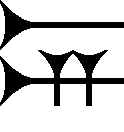
The cuneiform sign ni is a common-use sign of the Amarna letters, the Epic of Gilgamesh, and other cuneiform texts. It has a secondary sub-use in the Amarna letters for addressing the Pharaoh, from the vassal states of Canaan. The address to the Pharaoh is often 'King-Lord-Mine': LUGAL, EN-ia which has many varieties of expression. "LUGAL" is Akkadian language for "Šarru", English "king", and EN in Akkadian is bēlu, for "Lord",. In some Amarna letters the sub-use of ni is lí, for spelling "bēlu", be-lí often .

The cuneiform ša sign is a common, multi-use sign, a syllabic for ša, and an alphabetic sign used for š, or a; it is common in both the Epic of Gilgamesh over hundreds of years, and the 1350 BC Amarna letters.

The cuneiform di sign, also de, ṭe, ṭi, and sumerograms DI and SÁ is a common-use sign of the Epic of Gilgamesh, the 1350 BC Amarna letters, and other cuneiform texts. In the Akkadian language for forming words, it can be used syllabically for: de, di, ṭe, and ṭi; also alphabetically for letters d, ṭ, e, or i. Some consonant-pairs (d/t), are also interchangeable.

The cuneiform du sign, also kup, and sumerograms DU and GUB, is a common-use sign of the Epic of Gilgamesh, the 1350 BC Amarna letters, and other cuneiform texts. In the Akkadian language for forming words, it can be used syllabically for: du, or kup ; also alphabetically for letters d, u, k, or p. It is also true in the Akkadian language, that some consonants are paired, thus the relationship between kup, and sumerogram GUB is explained (k/G).

The cuneiform sign iš is a common use sign in the Amarna letters and the Epic of Gilgamesh. It is used syllabically for iš; also for mel, mil, and a Sumerogramic usage for IŠ. Alphabetically as "iš", its most common usage, it can be used for "i" or "š". In Akkadian, the four vowels a, e, i, o, are all interchangeable, and the three different "s", can also be interchanged: s, ṣ, š.
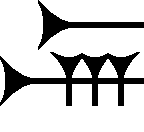

![]() .
.














